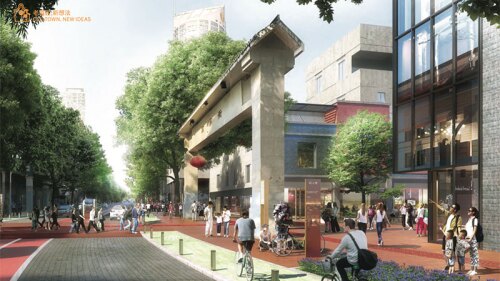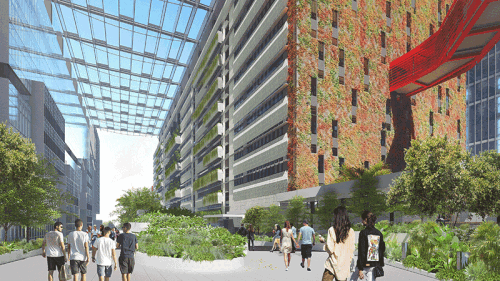Asia Pacific
Thirteen outstanding real estate development projects have been selected as winners of the 2020 ULI Asia Pacific Awards for Excellence. The winners, each of which demonstrates a comprehensive level of quality and a forward-looking approach to development and design, include four projects in China, two in Hong Kong, two in Australia, two in Singapore, and one each in India, Japan, and New Zealand.
Themes of identity, governmental responsibility, and local empowerment in cities were discussed by a small group of experts during a May 20 webinar hosted by ULI Asia Pacific. While the discussion leaders each offered their own talking points, all agreed that governance and design play crucial roles in the establishment of a modern community.
In recent decades, SOM’s urban design work in China has created several successful old town redevelopment planning projects—such as Shanghai Xintiandi and Foshan Lingnan Tiandi—that integrate China’s ancient urban heritage into a new type of urban placemaking, one that celebrates local traditions while also creating immeasurable economic, social, and cultural value. Guangzhou’s Old Town is the latest of these.
When the SARS epidemic surfaced in China in 2003, the impact on domestic real estate was severe but fairly short-lived, with rents and prices rebounding quickly once the outbreak had peaked. The fallout from COVID-19, however, promises to be more profound, as shrinking global demand for Chinese products turns the screw on firms that have only recently restarted operations, said industry experts working in the region.
Kenneth Rhee, executive director of ULI China Mainland, spoke with ULI leader Vincent Lo, chairman of Shui On Land, about his thoughts on the near-term impact of COVID-19 on China’s real estate market and how the urban environment and real estate industry will change.
The Punggol Digital District, set to launch in 2023, will form a fresh nexus between higher education and industrial innovation, with its two anchor institutions being the Singapore Institute of Technology and a new business park developed by JTC Corporation, an industrial property developer and manager.
At the 2020 ULI Singapore Conference, which was held virtually, panelists discussed how hotels have started to offer takeout and delivery to nonguests, in addition to working with the local government to house those under quarantine orders.
Many countries in Asia have successfully mitigated the spread of COVID-19 through a range of strategies that include universal mask use, testing, sophisticated technology for contact tracing, and strict government quarantine and cleaning protocols, according to leading real estate professionals participating in a recent ULI webinar. The participants described impacts on their real estate businesses, and how the real estate industry has been enlisted in the fight against the coronavirus.
Real estate investment in the Asia Pacific region has been on a downward trend since 2019, and market uncertainty brought about by the COVID-19 pandemic has exacerbated the situation, said speakers at a recent ULI Singapore event held virtually.
The Greater Sydney Commission (GSC) has prepared a 40-year vision for connecting and rebalancing growth and development in Greater Sydney, one of the fastest-growing regions in the developed world. In an event organized by ULI Australia and Urbis, GSC chief commissioner Lucy Turnbull presented the keynote, outlining how land use, transport, and infrastructure planning for the growth areas have for the first time been prepared concurrently.
Singapore
A seminar organized by the ULI Singapore NEXT Committee presented attendees with the little-known concept of real estate “tokenization,” or fractional investing/trading, as a potential bridge between private investors and direct ownership. Although not new, tokenization in real estate is a niche market, particularly in Asia Pacific, with Singapore hosting a small number of the specialized digital platforms.
Once the site of an abandoned quarry, Singapore’s Rifle Range Nature Park now serves as a buffer zone protecting one of the island nation’s last primary rainforests, Bukit Timah Nature Reserve, from encroaching development and human activity. Located to the reserve’s south, Rifle Range is Singapore’s first net-positive energy nature park, harvesting more energy than its annual operational requirements.
Fourteen developments from across Asia have been named winners of the 2025 ULI Asia Pacific Awards for Excellence, one of the real estate industry’s most prestigious honors. Announced at the 2025 ULI Asia Pacific Summit held in May in Hong Kong, this year’s award winners include projects in Australia, Bangladesh, China, India, Japan, the Philippines, and Singapore.
Hong Kong
We are late in the current cycle, and real estate investors are focusing on the potential risks as much as, if not more than, the rewards on offer, according to investors and investment managers discussing global capital markets at the 2018 ULI Asia Pacific Summit in Hong Kong.
Growing cities such as Hong Kong are at the epicenter of what Richard Florida has dubbed “the new urban crisis,” with the city’s success sending house prices soaring out of reach of the average resident. The author and urbanist, who is director of cities at the Martin Prosperity Institute at the University of Toronto, spoke at the 2018 ULI Asia Pacific Summit in Hong Kong.
While investment volumes in commercial real estate in Hong Kong were up strongly last year, flagship office buildings and prime development sites are beyond the reach of all but a handful of players. For most investors, more interesting opportunities lie in other, less-visible parts of the market. Rather than waiting for (and possibly missing) the next correction, investors who are willing to roll up their sleeves may find opportunities away from the spotlight.










